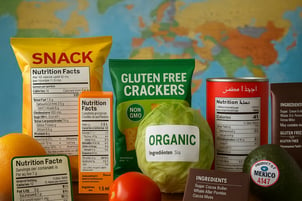What is Specification Management in a PLM Software?
Consumer awareness is at an all-time high, and the beauty and personal care industry has come under increasing scrutiny, for safety, transparency, and ethical responsibility. Nowhere is this more evident than in the European Union, where cosmetic products are regulated under one of the strongest legal frameworks in the world: Regulation (EC) No. 1223/2009. This growing demand for EU cosmetics regulation compliance has pushed brands to adopt stricter safety practices and transparent product development systems.
This regulation reflects the EU’s commitment to protect public health and help ensure that cosmetic products are of optimum quality and safety. Whether it be a moisturizer, shampoo, or a bottle of nail polish, if a product is marketed as a “cosmetic” in the EU, the product must comply with this regulation.
Due to its wide-ranging scope, the emphasis on human health, clear labelling of products, and high level of accountability of manufacturers and distributors, the EU Cosmetics Regulation is recognized as a model for regulatory systems globally.
In the following sections, we will explain the regulation, who it applies to, and why complying with it is both a legal requirement and a commercial necessity for brands seeking EU cosmetics regulation compliance.
Understanding the EU Cosmetics Regulation (EC) No. 1223/2009
Scope & Application
Regulation (EC) No. 1223/2009 is the dominant legal framework for cosmetic products across the European Economic Area, governing all products to be applied topically, for the teeth and for the mucous membranes, whether manufactured in the EU or imported from outside. It became fully effective on 11 July 2013, repealing the earlier directive and harmonising rules across all EU member states. Its unified approach enables brands to streamline EU cosmetics compliance across multiple markets.
Core Objectives
The regulation pursues three overarching goals:
-
Human Safety: Each cosmetic product must be subject to a scientific safety assessment and be established to be safe in use for its intended or reasonably foreseeable use. Annexes II–VI specify which substances are prohibited, restricted, or allowed only in controlled uses.
-
Clear Labeling: Labels must be easily interpreted, that is they correctly display the name/address of the person responsible for the product, product function, quantity of content, durability date or period after opening, a complete list of ingredient in INCI format, batch code, any precautions for use, and country of origin in the case of an imported product. All information must be legible, indelible, and provided in the local language.
-
Responsible Practices: Each product must have a Responsible Person, which could be the manufacturer, importer, distributor (if they have re-branded or altered the product), or a third-party in the EU. The Responsible Person must maintain compliance, keep the Product Information File, notify authorities as required, and manage corrective action such as recalls and issuance of safety warnings, if there is a safety concern. Achieving EU cosmetics regulation compliance depends heavily on fulfilling these responsibilities.
Key Definitions & Scope
What qualifies as a “cosmetic product” under EU law
Under Article 2 of EU Regulation (EC) No 1223/2009, a cosmetic product is defined as:
“any substance or mixture intended to be placed in contact with the external parts of the human body (epidermis, hair system, nails, lips, external genital organs) or with the teeth and mucous membranes of the oral cavity with a view exclusively or mainly to cleaning them, perfuming them, changing their appearance, protecting them, keeping them in good condition or correcting body odours.”
This broad definition includes skincare, makeup, hair care, oral hygiene products, and deodorants, but excludes medicines and biocides. The EU law requires a case-by-case assessment to determine a product’s legal categorization based on its intended use and formulation, a vital step in EU cosmetics compliance.
How cosmetics differ from pharmaceuticals and medical devices
The distinction rests on intended purpose and mode of action:
-
Cosmetics are designed to cleanse, beautify, improve appearance, and maintain external hygiene without altering bodily functions or structures.
-
Pharmaceuticals are designed to minimize, treat, prevent, or diagnose disease by pharmacological or immunological action.
-
Medical devices perform their principal intended action physically, such as surgical instruments or devices that convey an image of the structure of the body, rather than through chemical action or metabolic activity.
That means a cream tinted to conceal (cosmetic) differs from a medicated cream prescribed for eczema (pharmaceutical), even if they appear similar.
Safety & Product Information File (PIF)
Mandatory requirement for every product
In accordance with Article 11 of the Regulation, each cosmetic product must contain a Product Information File, which must be drawn up prior to placing any product on the market and available for 10 years from the last date of sale of a batch. The Product Information File must be held in storage at the address of the “responsible person” and be accessible and available in paper format or electronic format for authorities. The PIF serves as the core proof of EU cosmetics regulation compliance.
What a PIF must contain
According to both Regulation text and industry guidelines, the PIF includes:
-
Product description (intended use, target consumer demographics)
-
Cosmetic Product Safety Report (CPSR), formulated and updated by a qualified assessor
-
Manufacturing method and GMP compliance (ISO 22716 or equivalent)
-
Proof of claimed effects (e.g., moisturization, anti-aging results)
-
Labelling details, including full ingredient list, warnings, and instructions
-
Animal testing data, specifically the absence of EU animal tests
Together, these elements ensure transparency, consumer safety, claim authenticity, and regulatory readiness. Being fully PIF-compliant is important to build credibility and avoid market withdrawal or penalties.
Ingredient Regulations & Banned Substances
CosIng Database
Managed by the European Commission, CosIng is the authoritative online database for cosmetic substances under Regulation 1223/2009. It lists five categories according to the annexes (e.g. banned, restricted, approved colorants, preservatives, UV‑filters) and provides INCI names, regulatory status and SCCS opinions. It is important to note that even if it is found in CosIng, it does not automatically give approval of use, only ingredients listed in Annexes II–VI can be used accordingly.
Regulatory Categories
Under EU law:
-
Banned substances (Annex II): Strictly prohibited, unless present as unavoidable trace contaminants in safe amounts .
-
Restricted substances (Annex III): Permitted only under specified conditions (e.g. concentration limits, targeted product types) .
-
Approved colorants (Annex IV), preservatives (Annex V), UV-filters (Annex VI): only those on these positive lists may be used and only under prescribed conditions.
Nanomaterials & Allergenic Fragrances
Article 16 establishes that nanomaterials can only be used if expressly listed within the annexes, or else require additional EU authorization.
Fragrance allergens are regulated both under EU law and IFRA; substances classified under CMR categories (e.g. Lilial) are banned in cosmetics, even if allowed under IFRA guidelines
Role of REACH & CLP Regulations
Regulation 1223/2009 governs the use of products that are classified as "cosmetics", however, REACH (Regulation EC 1907/2006) involves registration, requirements for evaluation, and restrictions of chemical substances across many industries to reduce risk to both the environment and human safety and do not concern cosmetic use within the definition of REACH.
The regulation CLP (Regulation EC 1272/2008) requires hazard labeling of substances and mixtures without regard to the industry sectors downstream users might be involved with, which in part allows manufacturers to understand and convey risk.
Notification via CPNP
Prior to any cosmetic product being made available in the EU for consumer sale, the Responsible Person must submit information pertaining to key data, product identity, formulation, CPSR, labelling info, to the Cosmetic Products Notification Portal (CPNP). This generates a Central electronic file accessible to regulators and poison centres in each of the EU/EEA states. Completing CPNP notification is a core requirement for EU cosmetics compliance.
Good Manufacturing Practices (GMP) & ISO Standards
Article 8 of the regulation outlines the legal requirement for compliance with Good Manufacturing Practices. The ISO standard 22716:2007 is a globally recognized way of managing operational controls from raw materials through packaging and storage to ensure consistent quality and product safety. GMP compliance must also be recorded in the PIF.
Cross-Border Sales & Post-Brexit Implications
UK Regulations After Brexit
Following the end of the transition period on 31 December 2020, the UK implemented its own cosmetics framework under the UK Cosmetics Regulation (UKCR), largely mirroring EU rules but managed independently. Products for Great Britain (England, Scotland, Wales) must be notified via the new UK Cosmetics Portal (SCPN), overseen by a UK-based Responsible Person.
Dual Compliance for EU & UK Markets
Brands targeting both regions must adhere to separate systems:
-
EU market: registration through the CPNP, EU-aligned CPSR, and EU-based Responsible Person.
-
Great Britain: independent SCPN notification and UK-based Responsible Person.
-
Northern Ireland (NI): a unique case, it remains under EU Regulation EC 1223/2009, requiring CPNP notification even for UK-made products, while products sold in NI that meet EU standards may freely circulate in Great Britain.
Navigating NI compliance involves meeting both UKCR and EU obligations. Under the Northern Ireland Protocol and Windsor Framework, UK goods destined for NI but also acceptable in GB markets can be labelled “not for EU,” but NI must strictly comply with EU regulations
Market Surveillance, Penalties & Recalls
Role of Local Authorities
Local market surveillance authorities, usually trading standards offices conduct regular inspections, reviewing product labels, PIFs, CPSRs, and manufacturing practices. They monitor for safety risks and ensure accurate claims.
Common Triggers for Investigation
Issues that often prompt action include:
-
Reports of Serious Undesirable Effects (SUEs) from consumers or poison centers
-
Non-compliance in labeling, prohibited ingredients, or missing CPNP/SCPN notifications
-
Use of banned substances or unsafe ingredient levels
-
Substandard manufacturing practices or incomplete PIFs
Penalties & Recall Procedures
When a product poses health risks or is significantly non-compliant, authorities can mandate:
-
Pre-market hold (stopping further distribution)
-
Corrective actions (label adjustments, packaging changes)
-
Product Recall (including public notifications)
Penalties may include fines, product bans, or legal prosecution, depending on the severity.
Conclusion
The landscape for cosmetic products post-Brexit has become more complex. Brands that span EU, Great Britain, and Northern Ireland must juggle multiple notification systems, dual regulatory frameworks, and region-specific labelling. Understanding and complying with both EU and UKCR, supported by clear manufacturing standards and robust product documentation, is not just regulatory compliance; it's the foundation of consumer trust and viable market access. For any brand hoping to thrive in these markets, prioritizing EU cosmetics compliance and maintaining ongoing EU cosmetics regulation compliance are essential steps toward long-term success.
Tags:
Jul 1, 2025 3:39:01 PM






